Tuesday Apr. 11, 2006
Quiz #3 was returned in class today.
The Expt. 4 reports and revisions of the Expt. 3 reports
were collected today. Remember that Friday this week is the
deadline
for turning in the first draft of an experiment, book, or scientific
paper report. That is so that your report can be graded and
returned
to you with enough time for you to revise your report.
Reports turned in last week have been graded and were returned in class.
An in-class optional assignment was
distributed in class today.
To earn full credit on the assignment it had to be turned in at the end
of class. You can turn in the assignment at the beginning of class on
Thursday for
partial credit.
We'll be
covering a little bit of material from Chapter 6 today (it may run into
the first part of Thursday's class also)
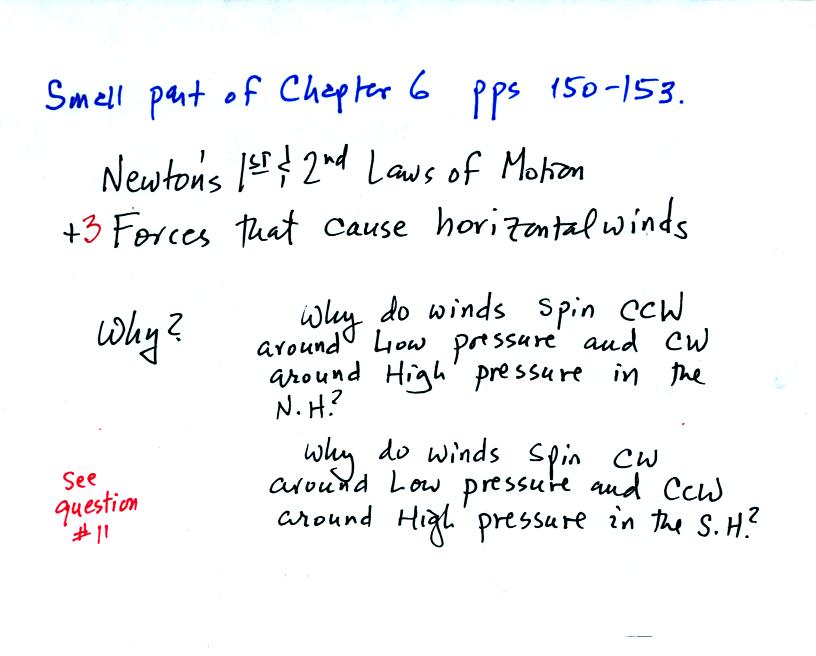
We'll learn why winds spin counterclockwise (CCW) around Low
pressure
and clockwise (CW) around High pressure in the northern
hemisphere. We'll see why the spinning winds reverse
direction in the southern hemisphere. You may already have been
to the southern hemisphere or you may go there one day. You'll
probably hear about how the Coriolis force or the Coriolis effect
causes water draining out of sinks and toilet bowls to spin in the
opposite direction in the southern hemisphere (it's not true).
That's another reason for covering the Coriolis effect in NATS
101. The "see question #11" on the figure above refers to one of
the questions on the In-class Optional Assignment.
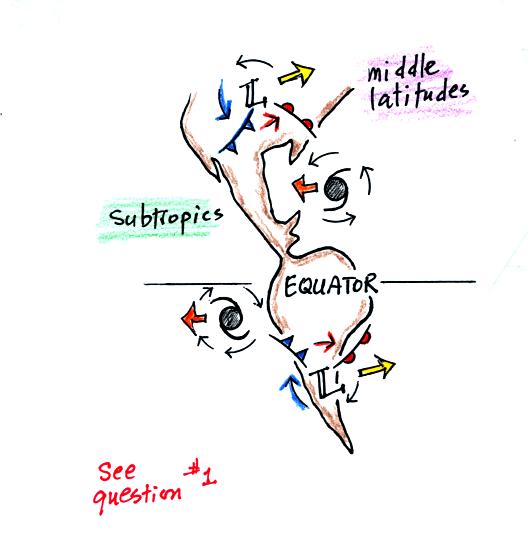
This figure (on a class handout) shows the winds spinning around
middle latitude storms
(extratropical cyclones) and hurricanes (tropical cyclones) in both the
northern and southern hemispheres. The term cyclone refers to
winds blowing around low pressure. Note how the directions of the
spinning winds change as you move from one hemisphere to the other.
Note how middle latitude storms tend to move from west to east in both
hemispheres. Hurricanes, which are found in the subtropics, move
from east to west in both hemispheres. We will learn more about
why this occurs on Thursday.
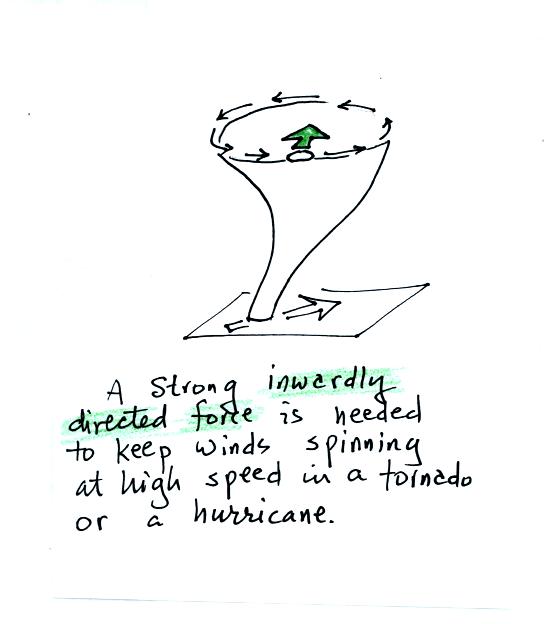
After studying Newton's laws of motion you will appreciate
why an
inwardly directed force is need to keep winds spinning in a
circle. In the case of the rapid winds in a tornado, a very
strong force is needed (it turns out to be the pressure gradient force
(PGF) or pressure difference force).
Now on to Newton's 1st and 2nd laws of motion and some graphical
illustrations of what they mean.

The 1st law really has two parts: one that deals with stationary
objects and another that treats moving objects.
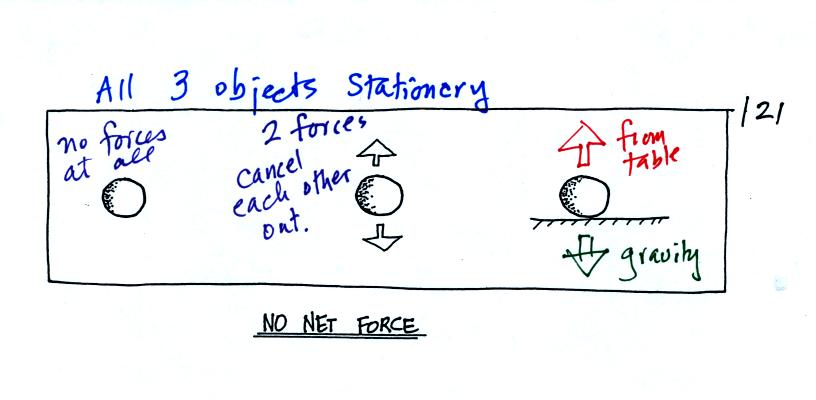
A stationary object is shown in all three figures
above. In
the left example there aren't any forces at all being exerted on the
object, there is no reason for it to suddenly start to move. In
the middle and right examples there are two forces present but they are
of equal strength and point in opposite directions. They cancel
each other out and the net force or total force is zero. Again
the
stationary object won't suddenly begin to move.
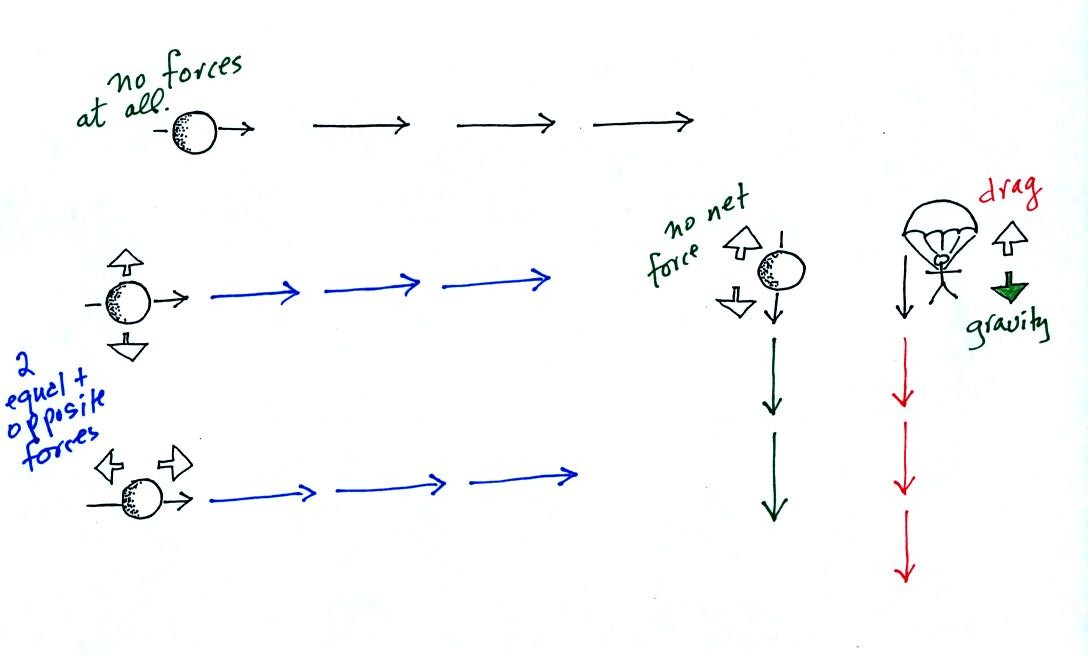
In all of these examples (on p. 121 in the photocopied
notes) the
next force is zero (the two forces present in examples #2, #3, #4, and
#5 cancel each other out). The object will continue to move in a
straight line at constant speed (the thin arrows show the direction of
motion, the length of the arrow provides an idea of speed).

Next we look at cases where this is a net force.
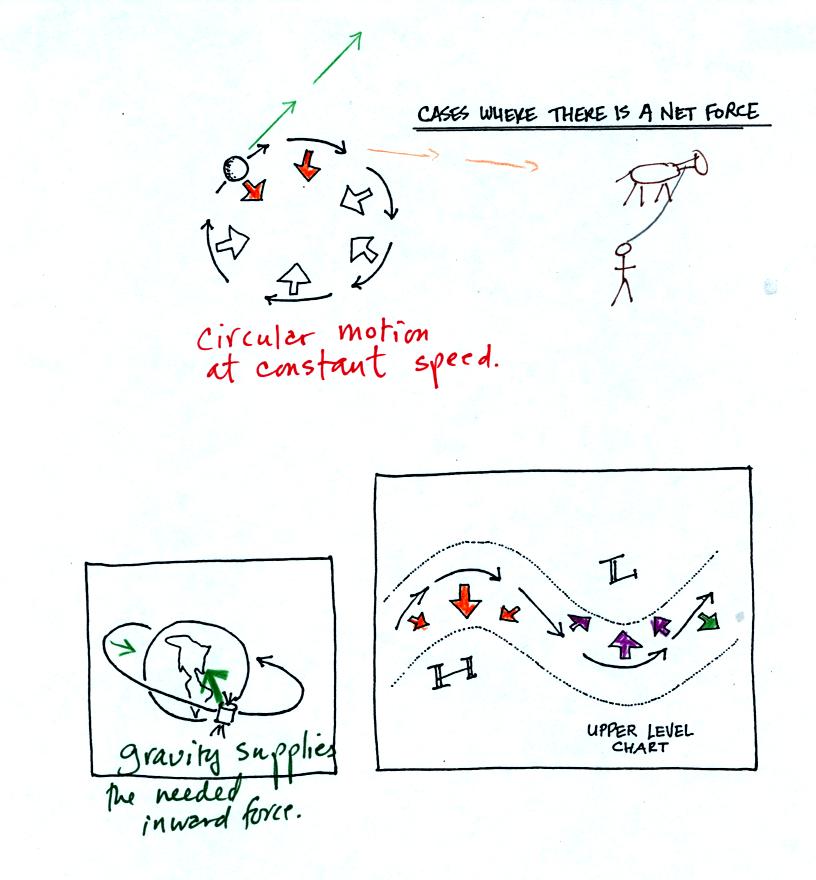
If there were no net force at the point indicated, Newton's
1st law of
motion would say the object would travel in a straight line at constant
speed (the light green arrows). But the object turns to the
right. A force acting perpendiculary and to the right of the
object's direction of motion is needed.
Gravity provides the constant inward pointing force needed to keep a
satellite in orbit around the earth. Upper level winds blowing
through ridges and troughs need net forces that point sometimes to the
right of the wind and sometimes to the left of the wind to keep the
winds blowing parallel to the contour lines.
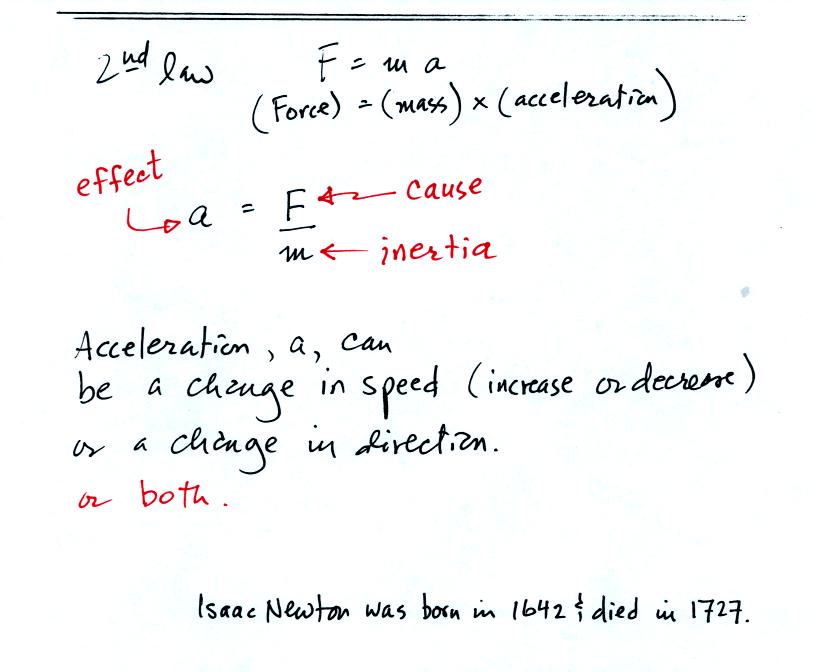
The 2nd law of motion really just say that if you exert a net
force on
an object it will acceleration (i.e. start moving, speed up or slow
down, start moving in a different direction).
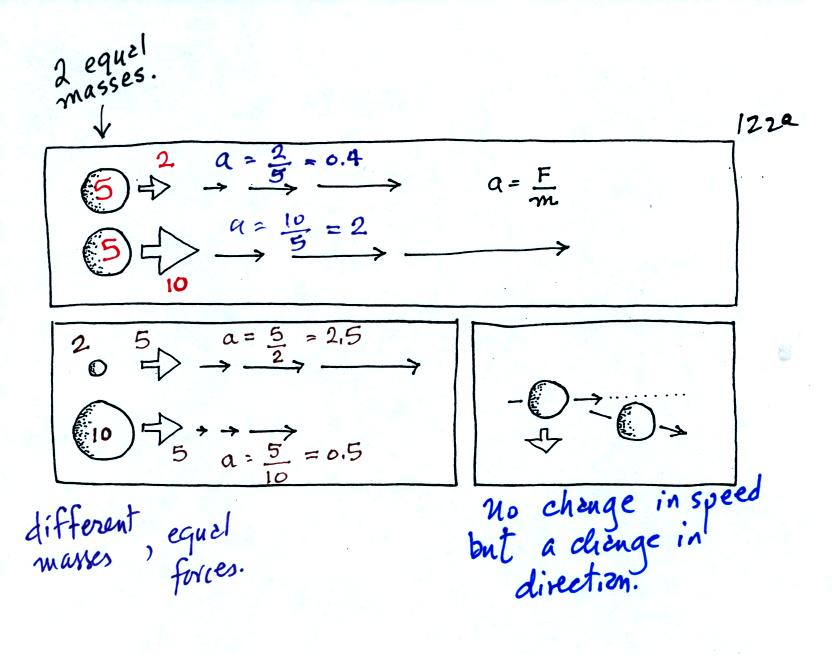
In the first example unequal forces (2 and 10) are applied
to equal
masses (5 and 5). You can calculate the acceleration
by dividing force by mass. This gives you the acceleration, the
lower object will speed up ten times faster than the top object which
has a weak force exerted on it.
In the bottom example equal forces (5 and 5) are applied to two
different masses (2 and 10). Mass can be thought of
as inertia. An object with a large mass is resistant to a change
of
direction or speed. A large object is harder to start moving than
a small object (imagine pushing a stalled Volkswagen and a stalled
Cadillac out of an intersection)
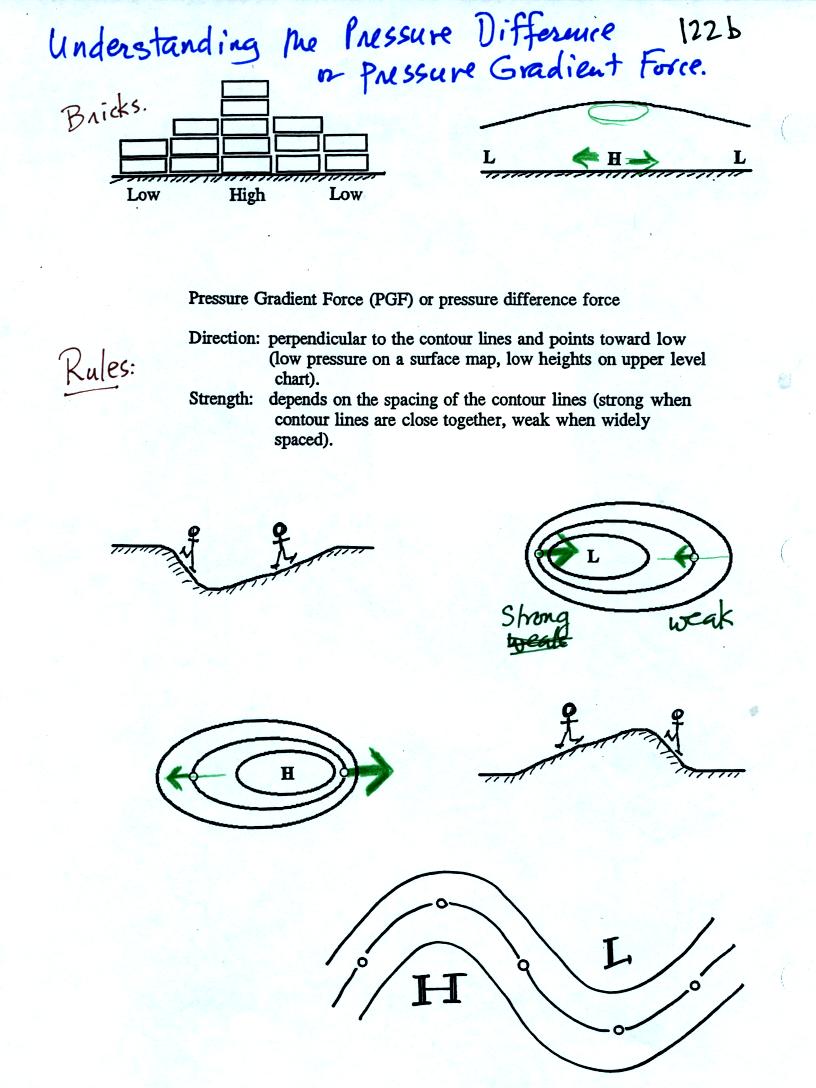
Pressure differences create a force that points from high pressure
to
low pressure. On a weather map the pressure gradient force (PGF)
always points perpendicular to the contours on the map and from high
toward low. The PGF force is strong when the contours are
closely spaced and weak when the contours are further apart.
Some examples of PGF force directions and relative strengths are shown
at the bottom of the figure. Note the analogy between weather
maps and geographical features like hills and valleys.
AFter studying this information for a while, see if you can answer
Question #7 on the In-class optional assignment.
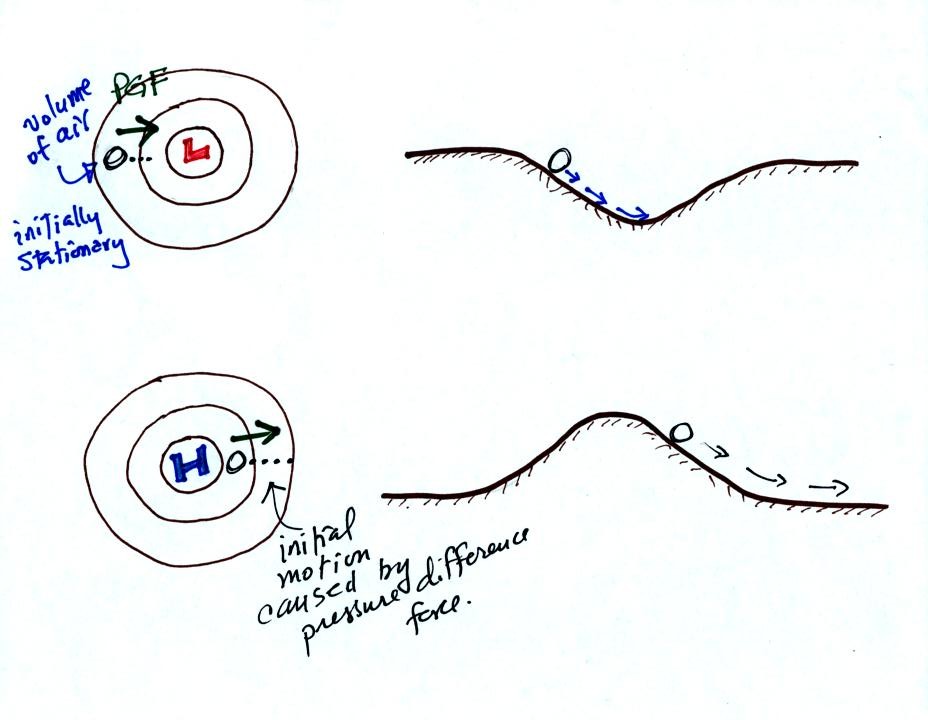
The PGF can cause stationary air to begin to move. In
the top
example a stationary volume of air is placed in a center of low
pressure. The PGF will cause the air to begin to move toward low
pressure in the center of the picture. The dotted line shows the
direction of initial motion. This like placing a ball on the side
wall of a valley. The ball will roll downhill.
In the second example, a center of high pressure, the PGF causes a
stationary volume of air to again begin to move toward low pressure
which is outward and away from high pressure. In the analogy a
ball placed on the side of a hill will roll downhill and away from the
summit.
So given a pressure pattern you should be able to determine the
direction of initial motion (see Question #8). Or as in Question
#10 you should be able to determine whether the motion is being caused
by a center of high or low pressure.
Now on to the Coriolis force (some of the diagrams below were modified
slightly from those drawn in class)
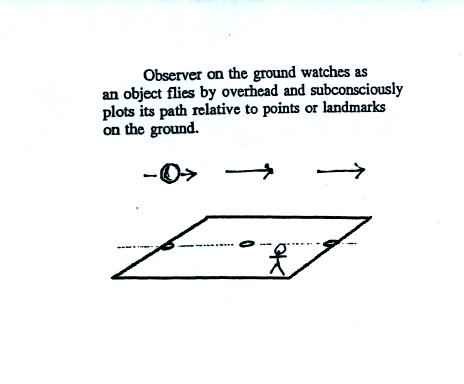
The figure above is from p. 122c in the photocopied
notes.
Imagine that a flying saucer flies over Tucson. It travels
straight from west to east. The next figure shows the path that
the saucer would appear to have followed as it passed over the city.
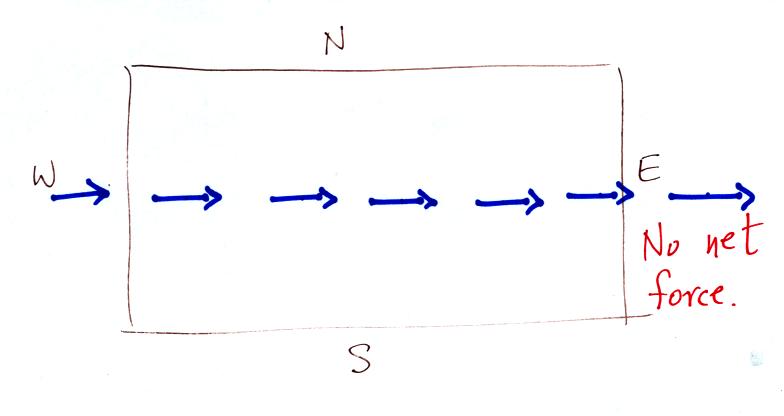
The flying saucer appeared (relative to the ground) to be
moving in a
straight line at constant speed. You would conclude that there
was zero net force acting on the flying saucer.
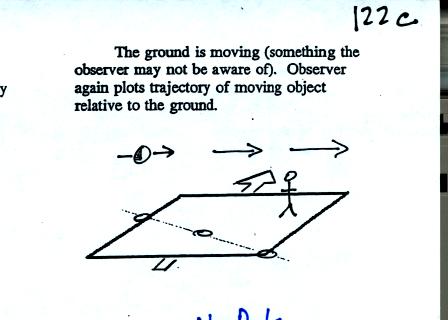
In this second picture the flying saucer flies by overhead
just as it
did in the previous picture. In this picture, however, the ground
is moving (don't worry about what might be causing the ground to move).
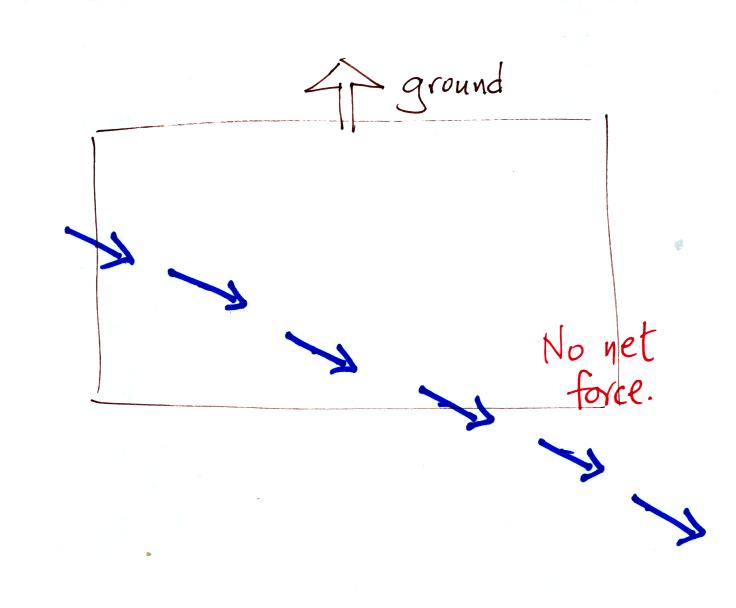
This is the path that you would see relative to the ground
in this
case. Even though the flying saucer flew from west to east it
appears to have been traveling from the NW toward the SE because the
ground was moving as the flying saucer passed overhead. Because
the motion is still in a straight line at constant speed, you would
conclude the net force acting on the flying saucer was zero.
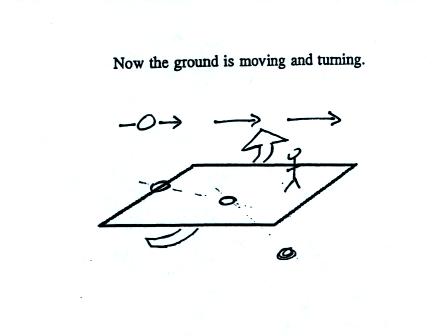
In this last figure the flying saucer flies by again from
west to
east. In this case however the ground is rotating.
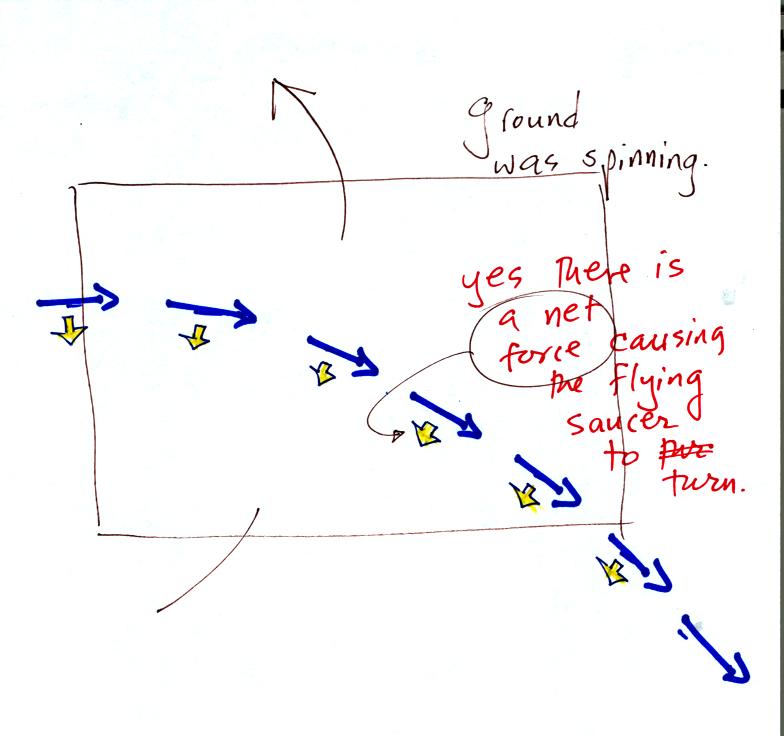
Now the flying saucer appears to have been turning to the
right as it
passed over Tucson. Because it is no longer traveling in a
straight line you would conclude there was a net force acting on the
flying saucer. The direction of this net force would be to the
right of the motion.
At most locations on the earth the ground is rotating. This is
most easily seen at the poles.
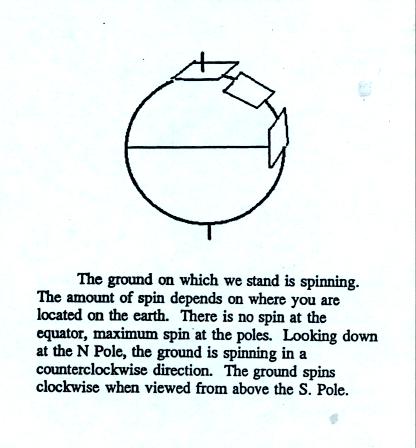
Imagine a piece of paper glued to the top of a globe.
As the
globe spins the piece of paper will rotate. A piece of paper
glued to the globe at the equator won't spin, it will flip over.
At points in between the paper would spin and flip, the motion gets
complicated.
The easiest thing for us to do is to ignore the fact that the ground on
which we are standing is rotating. However, if we do that we need
to account for the curved paths that moving objects will take when they
move relative to the earth's surface. That is what the Coriolis
force does.
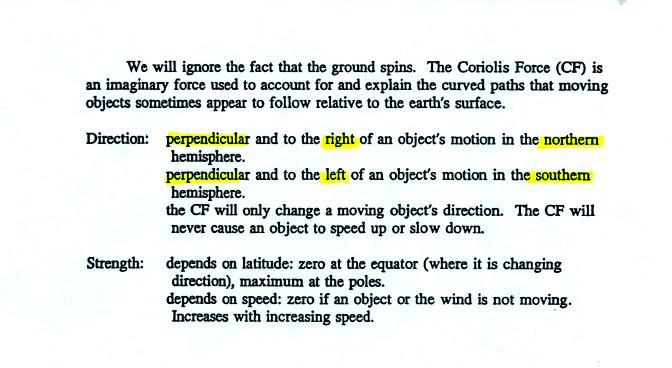
Here are some rules that you can use to determine the
direction and
strength of the Coriolis force. It always points in a direction
that is perpendicular to the wind, it can't cause the wind to speed up
or slow down, it will only change the wind's direction.
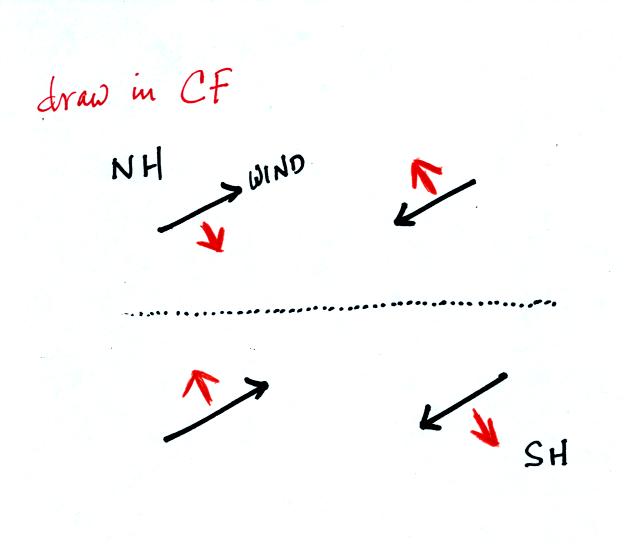
The red arrows show the direction of the CF in the northern
and
southern hemispheres. The CF is to the right of the wind (you
need to look in the direction the wind is blowing, you need to look
downstream) in the northern hemisphere and to the left of the wind in
the southern hemisphere. This figure and the next 2 figures were
on a class handout distributed in class.
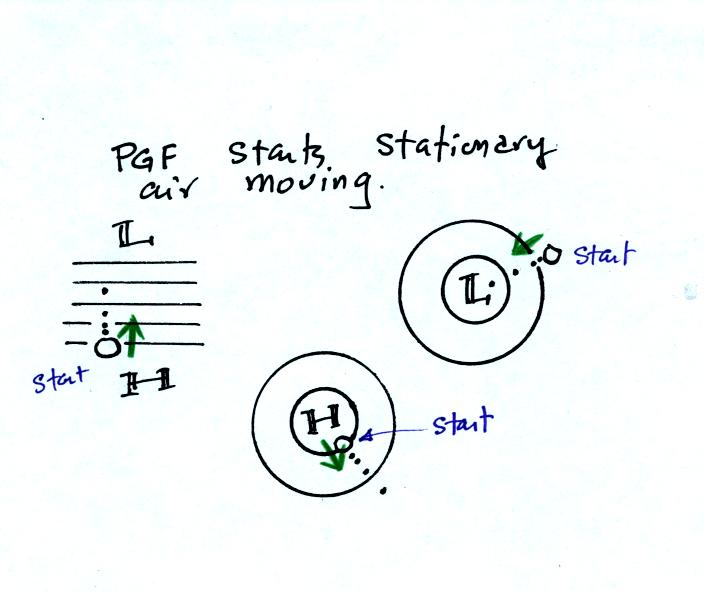
As we saw earlier, the PGF is the only force that can cause
stationary air to begin to move.

Once the wind begins to move the Coriolis force can cause it
to turn to
the right or left.
Air in the upper left figure begins to move toward the Low at the top
of the figure. The CF then turns the wind to the right (this
tells you this is a northern hemisphere map). The wind ends up
blowing parallel to the contour lines. When the contour lines are
straight, the wind will blow in a straight line at constant
speed. The net force will be zero, the PGF and CF point in equal
directions and have the same strength. They cancel each other out.
Winds will spin counterclockwise around low in the northern hemisphere
and clockwise around lows in the southern hemisphere. The winds
blow parallel to the circular contour lines. A net inward force must be
present in order for the wind to be able to blow in a circular path
like this. In these two low pressure center examples, the inward
PGF is a little stronger than the outward pointing CF.
The back
page of the class handout had a bunch of other examples that you can
study and turn in at the beginning of class on Thursday as
an optional assignment.






















